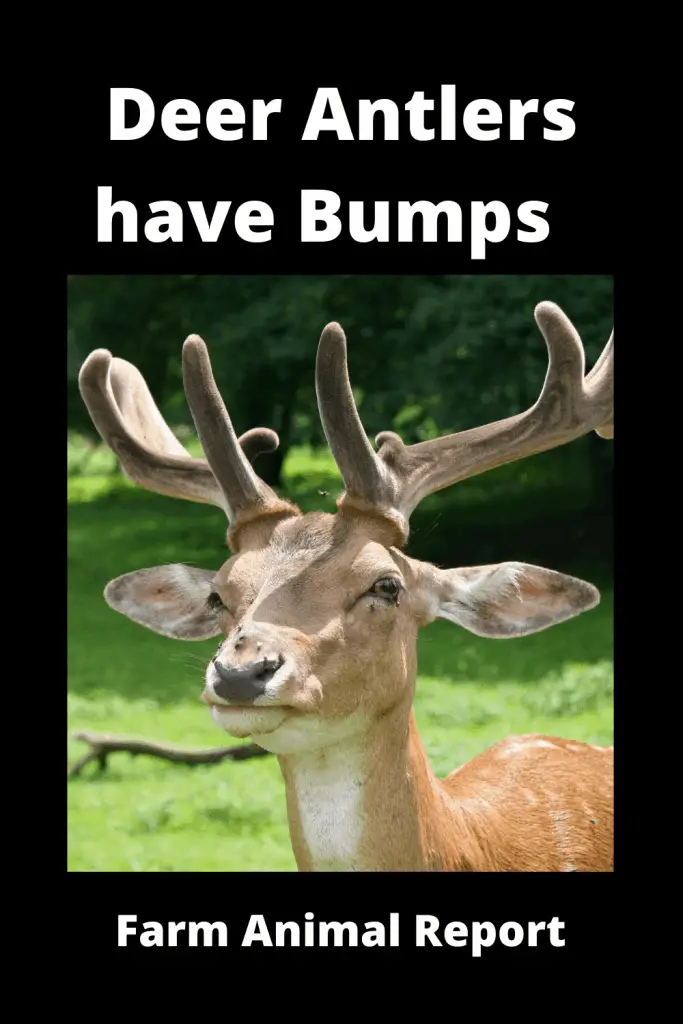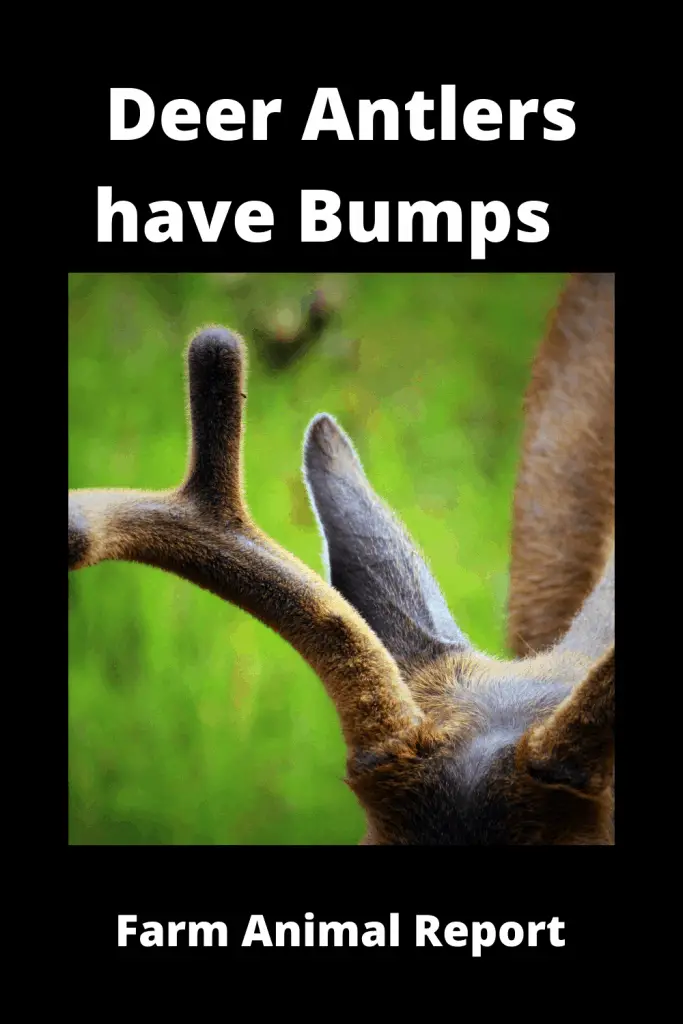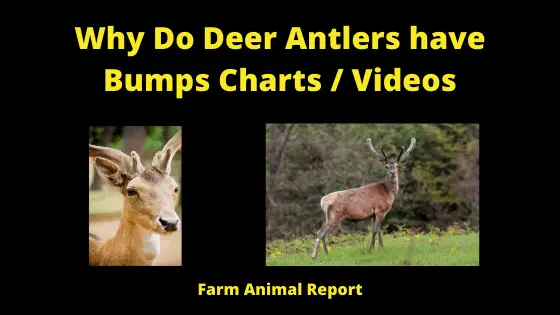Deer Antlers have Bumps / Types of Deer Antlers
Deer Antlers have Bumps. Antlers are often called “horns” by deer hunters, but they are not. Horns are found on sheep, goats, and cows and are formed from hair-like tissue that grows over a bony core. Horns are typically not shed, and some species, like bighorn sheep, can be aged by counting the annual growth rings on their horns.
Check Out Amazons Educational Books on Whitetail Deer
Unlike horns, antlers are true bone and are composed primarily of calcium and phosphorus and are deciduous. Deciduous means antlers are dropped or shed and grown anew each and every year. They grow from pedicels located on the frontal bone of the skull. The pedicels which begin growing at a couple of months of age in buck fawns provide the base from which the antler will grow. The small hair covered bumps on a six-month-old male fawn’s head (a button buck) are the pedicels.

They are not antlers. Infantile antlers or actually hardened antlers on a buck fawn have not been documented in Virginia but have been reported in other states. Deer grow their first set of antlers when they are approximately one year of age.
The skin or tissue that develops at the top of the pedicel reacts to hormones in the deer body and actually causes an antler to grow/develop. The most interesting aspect of this antler growth tissue is that, if it is surgically removed and grafted to another part of the deer’s body, an antler will grow there.
For example, it would be possible to surgically produce a unicorn deer or a deer with 10 antlers growing out of its skull or any other part of the body.
See Our Extensive Article – 7 Ways Deer Farmers Make Money
The annual antler cycle is ultimately controlled by day length or photoperiod. The brain contains a kind of clock that measures the periods of light and dark and uses this information to ultimately control the secretion of the reproductive hormone testosterone in males.
Testosterone controls the antler cycle. In tests, bucks kept in constant 12 hours of light and dark were unable to shed their antlers and grow new ones, and
bucks kept in constant light grew and lost three sets of antlers in two years.
The growth of antlers typically begins in April in response to increasing day length. In fact, antler growth is one of the fastest known types of tissue growth in mammals, and a deer’s antlers can grow at a rate of ¼ inch per day.

Antler growth begins by a bud forming on the pedicel. Within a month the first tine or brow tine will have begun to form or split off. Approximately a month later, the second tine (G 2) will have begun to form. In just four months, the antlers are fully developed. During the summer months of antler growth, bucks live in reclusive bachelor groups and restrict their movements.
Deer Antler Age Chart / Terminology
When the antlers are growing, they are full of nerves and blood vessels and are covered with hairy skin covering tissue commonly called “velvet.” Antler growth is like building a skyscraper. What is first built in the structure or a frame or matrix?
New Zealand Free Range Deer Farming / Velvet
- Sterile Surgical Procedure
- Removed By Licensed Veterinarians
- Industry Standards
- Inspected in Hygienic Conditions
- Quality Licensed Standards
- Processed for Human Use
- Frozen Antler – Thawed – Removed to Dehydrator
- Packaged for Export
- Air Freighted to its Worldwide markets
Think of pouring concrete; you must first build a form. That is what deer do. During the early summer, deer antlers are soft to the touch or spongy. Towards the middle of summer, as the form is being finished, the deer begins to “pour” the bone.
By late summer, as day length decreases, testosterone levels begin to increase, the form is filled, and the antler begins to harden. Finally, the blood vessels within the antler itself are filled and lose their ability to nourish the velvet, and it dries up and falls off.
The velvet is typically totally removed in a day, and some of it may be eaten by the buck. In Virginia, most deer are in hard antler by September 15th. Contrary to popular belief, deer do not rub their antlers on trees just to remove the velvet. In any given year, an individual buck may make hundreds of rubs, 99.9% of which are made after the velvet has already been removed.
Hard antlers remain on the deer through the peak of breeding until late fall or early winter. In response to continuing shortening of daylight and decreasing testosterone levels after the rut, an abscission zone forms at the junction of the pedicel and antler.
Erosion of the bone takes place at this seam and eventually, the antler falls off, leaving a bloody depression that quickly scabs over. Both antlers may fall off at exactly the same time, or one antler may be held for weeks or months after the first antler is shed.
Deer Antler Age / Size of Deer Antler
Antler size is determined by three factors: age, nutrition, and genetics.
Deer Antler Age Calculation
is the simplest factor and also easy to manage. Simply put, as a buck gets older, his antlers get bigger. When a buck is 1-1/2 years of age and grows his first set of antlers, average he will have four points, a 16 mm or 5/8-inch antler beam diameter (~ dine diameter), and just over an 8-inch outside spread.
By the time he is 2-1/2, the average buck has grown to 7 antler points, 24 mm or 15/16-inch beams (quarter diameter), and has about a 14-inch outside spread. If you want to hunt/kill big bucks, these 2-1/2-year-old bucks should also not be shot. At 3-1/2 and older, he will average 8 points, 29 mm or 1-1/8-inch beams, and a greater than 16-inch outside spread.
Deer Antler Nutrition
is also simple; a deer has to have enough to eat to grow antlers. In overabundant deer, herd condition suffers, and antler characteristics can also be expected to be compromised. The best way to address deer overabundance is to kill more does and reduce the deer herd density.
Typically, there is a direct inverse relationship between deer density and the physical condition of animals within a herd. As deer population density increases, overall herd condition and reproductive rates decline. Conversely, as deer population density decreases, health improves and reproductive rates rise.
With all that said, feeding deer and putting out mineral licks will not make deer grow big gigantic antlers like the pictures on the bags because it cannot make them older.
Are Deer Antlers Genetic
is not simple. For example, the old hunter’s tale that once a spike always a spike is not true, but that is not to say genetics does not play a role in deer antlers. Research done by the Texas Parks and Wildlife Department has proven that antler characteristics are inheritable (i.e., they can be passed from generation to generation), but it may be a moot point; because when a hunter looks through a scope and sees a deer, he cannot see its genes.
In free-ranging deer, managing antler genetics may not be possible. Hunters will often say, “Well, stock some of those big Illinois deer and let them breed!” First of all, how long would they survive? Maybe a day and, if they did survive, their “genetics” would not have any measurable impact. It would be akin to putting one drop of red food dye in the Pacific Ocean and expecting it to turn red. It would not work.
Deer / Cervid Farming / Profitability Table
| Deer Type | Ave Weight | Average Calves/Yr | Gestation | Meat Retail Price/lb |
|---|---|---|---|---|
| White Tailed | 150 | 2 | 201 | $ 38.95 |
| Mule | 120 - 320 | 2 | 203 | $ 7 - 9.50 |
| Elk | 71- - 730 | 1 | 240 - 262 | $ 44.95 |
| Reindeer | 350 - 400 | 1 | 222 | $ 74.95 |
| Moose | 840 - 1500 | 1 | 243 | $ 7.50 |
| Sika | 93 | 1 | 224 | 34.95 |
| Red | 440 | 1 | 236 | $ 35.95 |
| Pere David's | 370 | 1 | 286 | |
| Axis | 79 | 2 | 227 | $ 29.99 |
| Mutjah | 30 | 1 | 214 | $ 39.95 |
Livestock Fencing Height Tables
| Type of Livestock | Height of Fence | Spacing of Post Wood - $9.88 Steel - $3.58 | Best types Fencing | Price Per Roll |
|---|---|---|---|---|
| Horse | 54" x 60" | 8' | Electric Wire Wood | $ 189.00 |
| Cattle | 48" | 8' | Barbed Woven Electric | $ 259.00 |
| Sheep | 48" | 8' | Electric Woven Barbed | $ 259.00 |
| Buffalo | 5' 3" - 5' 6" | 8' | Barbed Electric | $ 249.00 |
| Deer | 6' - 10' | 8' | Woven Wire | $ 339.00 |
| Alpaca | 48" | 8' | Woven Electric | $ 259.00 |
| Pig | 2' - 3' Buried in Ground Pigs root | 6' - 8' apart | Woven Wire Barbed line on top and bottom | $ 259.00 |
| Chicken | 6' | 8' | Galvanized Hardware Cloth Chicken Wire | $ 57.99 |
| Rabbit | 3' | 8' | Chicken Wire Bury 1 foot | $ 29.00 |
Cost of Fence per Foot 2020 Tractor Supply Pricing
Types of Deer for Deer Farming
| Breed of Deer | Weight | Price of Venison | ||
|---|---|---|---|---|
| Whitetail | Buck - 150 lb Doe - 100 lbs | $ 29.50 | ||
| Mule | Buck - 150 - 300 lbs Does - 95 - 200 lbs | $ 44.95 | ||
| Red | Buck 350 - 530 lbs Doe 260 - 370 lbs | $ 21.95 | ||
| Fallow | Buck - 130 - 200 lbs Does - 60 - 90lbs | $ 39.95 | ||
| Axis | Bucks 150 - 250 lbs Does 90 - 150 lbs | $ 43.95 | ||
| Reindeer | Buck 350 - 400 lbs Does - 180 - 260 lbs | $ 74.95 |


